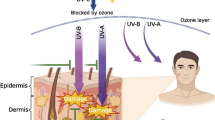Summary
The effect of diazepam (10 mg, p.o.) on the responsiveness of eccrine sweat glands to intradermally injected carbachol and on critical flicker fusion frequency was compared in 6 male healthy volunteers under two ambient temperature conditions, 22 °C and 35 °C. Carbachol evoked dose-related increases in sweat gland activity. Responsiveness to carbachol was significantly enhanced under the 35 °C condition as compared to the 22 °C condition, this being reflected in a higher value of Emax of the dose-response curve for carbachol under the 35 °C condition. Diazepam had no significant effect on responses to carbachol under the 22 °C condition, but prevented the increase in responsiveness produced by high ambient temperature. High ambient temperature had no significant effect on critical flicker fusion frequency. Diazepam significantly reduced critical flicker fusion frequency under both temperature conditions. It is suggested that diazepam may block the increase in sympathetic outflow normally evoked by high ambient temperature, thereby preventing the development of sweat gland hyper-responsiveness.
Similar content being viewed by others
References
Bini G, Habbarth KE, Hynniken P, Walliss BG (1980) Regional similarities and differences in thermo-regulatory vaso- and sudomotor tone. J Physiol 306: 553–556
Buceta JM, Bradshaw CM, Szabadi E (1985) Hyper-responsiveness of eccrine sweat glands to carbachol in anxiety neurosis: Comparison of male and female patients. Br J Clin Pharmacol 19: 817–822
Clubley M, Bye CE, Henson T, Peck AW, Riddington C (1978) A technique for studying the effects of drugs on human sweat gland activity. Eur J Clin Pharmacol 16: 221–226
Dobson RL, Sato K (1972) The stimulation of eccrine sweating by pharmacologic agents. In: Montagne W, Stoughton RB, van Scott EJ (eds) Pharmacology and the skin. Appleton-Century-Crofts, New York
Lader MH (1975) The psychophysiology of mental illness. Routledge and Kegan Paul, London
Lamb K, Bradshaw CM, Szabadi E (1983) The responsiveness of human eccrine sweat glands to choline and carbachol: Application to the study of peripheral cholinergic functioning in Alzheimer-type dementia. Eur J Clin Pharmacol 24: 55–62
Lewis D (1960) Quantitative methods in psychology. McGraw-Hill, New York
Longmore J, Bradshaw CM, Szabadi E (1985) Effects of locally and systemically administered cholinoceptor antagonists on the secretory response of human eccrine sweat glands to carbachol. Br J Clin Pharmacol 20: 1–7
Maple S, Bradshaw CM, Szabadi E (1982) Pharmacological responsiveness of sweat glands in anxious patients and healthy volunteers. Br J Psychiatr 141: 154–161
Ogata K, Ichihashi T (1935) Sweat reflexes due to changes in posture of the human body. J Orient Med 3: 95–97
Randall WC, Kimura KK (1955) The pharmacology of sweating. Pharmacol Rev 7: 365–397
Sigg EB, Sigg TD (1969) Hypothalamic stimulation of preganglionic autonomic activity and its modification by chlorpromazine, diazepam and pentobarbital. Int J Neuropharmacol 8: 567–572
Smith JM, Misiak H (1976) Critical flicker frequency (CFF) and psychotropic drugs in normal human subjects — a review. Psychopharmacology 47: 175–182
Theofilopoulos N, Szabadi E, Bradshaw CM (1984) Comparison of the effects of ranitidine, cimetidine and thioridazine on psychomotor functions in healthy volunteers. Br J Pharmacol 18: 135–144
Thomson ML, Sutarman (1953) The identification and enumeration of active sweat glands in man from plastic impressions of the skin. Trans R Soc Trop Med Hyg 47: 412–417
van den Broek MD, Bradshaw CM, Szabadi E (1984) The effects of a psychological ‘stressor’ and raised ambient temperature on the pharmacological responsiveness of human eccrine sweat glands: Implications for sweat gland hyper-responsiveness in anxiety states. Eur J Clin Pharmacol 26: 209–213
Wilkinson GN (1961) Statistical estimations in enzyme kinetics. Biochem J 80: 324–332
Author information
Authors and Affiliations
Rights and permissions
About this article
Cite this article
Banjar, W., Longmore, J., Bradshaw, C.M. et al. The effect of diazepam on the responsiveness of human eccrine sweat glands to carbachol: Influence of ambient temperature. Eur J Clin Pharmacol 31, 661–665 (1987). https://doi.org/10.1007/BF00541292
Received:
Accepted:
Issue Date:
DOI: https://doi.org/10.1007/BF00541292




